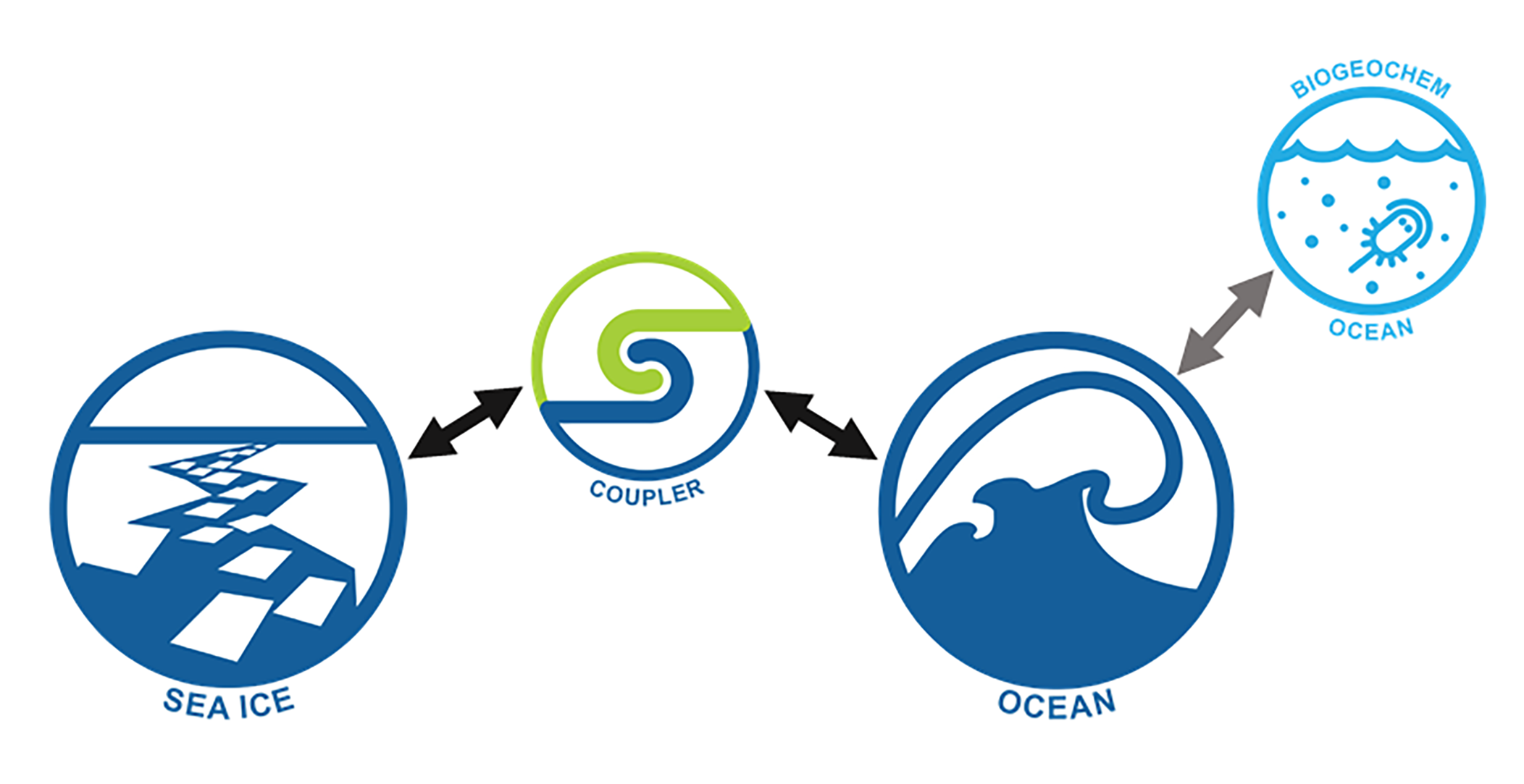ACCESS-OM

The ACCESS Ocean Model (ACCESS-OM) is a global coupled ocean model that includes ocean, ocean biogeochemistry, and sea ice components, linked together by a coupler.
The atmospheric fields that drive the model are provided by a data source, usually derived from reanalysis.
ACCESS-OM2
ACCESS-OM2 1 2 3 4 5 is a suite of coupled ocean-sea ice models originally developed by the Consortium for Ocean-Sea Ice Modelling in Australia (COSIMA).
ACCESS-NRI has released ACCESS-OM2 configurations as an adaptation of those originally developed by COSIMA.
There are global configurations for three spatial resolutions:
- 1° horizontal resolution, 50 vertical levels.
- 0.25° horizontal resolution, 50 vertical levels.
- 0.1° horizontal resolution, 75 vertical levels.
For each resolution there are two options of JRA55-do atmospheric forcing:
- Repeat Year Forcing (RYF): repeated 1 May 1990 - 30 April 1991 forcing
- Interannual Forcing (IAF): 1958-2018 forcing
Each configuration also has an optional biogeochemical (BGC) configuration that uses the Biogeochemistry Ocean component, if required.
Warning
BGC experiments are slower and generally consume more resources (compute time and disk space).
Model Components
-
Ocean: MOM5.
Tripolar grid, 10.250.1° spatial resolution, 505075 vertical levels. -
Ocean Biogeochemistry: WOMBAT (optional).
-
Sea ice: CICE5.1.2.
Same grid as ocean. -
Coupler: OASIS3-MCTv2.
More details on the models can be found in this ACCESS-Hive Forum post, together with details on the extensive control experiment data already available without needing to run a new experiment.
Full conditions of use for ACCESS-OM2 models and outputs can be viewed in the ACCESS-OM2-configs README.
-
A. E. Kiss, A. McC. Hogg, N. Hannah, F. Boeira Dias, G. B. Brassington, M. A. Chamberlain, C. Chapman, P. Dobrohotoff, C. M. Domingues, E. R. Duran, M. H. England, R. Fiedler, S. M. Griffies, A. Heerdegen, P. Heil, R. M. Holmes, A. Klocker, S. J. Marsland, A. K. Morrison, J. Munroe, M. Nikurashin, P. R. Oke, G. S. Pilo, O. Richet, A. Savita, P. Spence, K. D. Stewart, M. L. Ward, F. Wu, and X. Zhang. ACCESS-OM2 v1.0: a global ocean–sea ice model at three resolutions. Geoscientific Model Development, 13(2):401–442, 2020. URL: https://gmd.copernicus.org/articles/13/401/2020/, doi:10.5194/gmd-13-401-2020. ↩
-
Andrew E. Kiss, Andrew McC. Hogg, Russell Fiedler, Nicholas Hannah, Marshall L. Ward, Ryan M. Holmes, Navid C. Constantinou, Adele K. Morrison, Christopher C. Chapman, and others. A technical description of ACCESS-OM2, the Consortium of Ocean-Sea Ice Modelling in Australia's global ocean and sea ice model. 2017–. A living document; latest version is at \url https://github.com/COSIMA/ACCESS-OM2-1-025-010deg-report. URL: https://github.com/COSIMA/ACCESS-OM2-1-025-010deg-report. ↩
-
A. Solodoch, A. L. Stewart, A. McC. Hogg, A. K. Morrison, A. E. Kiss, A. F. Thompson, S. G. Purkey, and L. Cimoli. How does Antarctic Bottom Water cross the Southern Ocean? Geophysical Research Letters, 49:e2021GL097211, mar 2022. URL: https://doi.org/10.1029/2021GL097211, doi:10.1029/2021GL097211. ↩
-
Hakase Hayashida, Andrew E. Kiss, Toru Miyama, Yasumasa Miyazawa, and Sayaka Yasunaka. Anomalous nutricline drives marked biogeochemical contrasts during the Kuroshio large meander. Journal of Geophysical Research: Oceans, 128(7):e2023JC019697, jul 2023. URL: https://doi.org/10.1029/2023jc019697, doi:10.1029/2023jc019697. ↩
-
Laurie C. Menviel, Paul Spence, Andrew E. Kiss, Matthew A. Chamberlain, Hakase Hayashida, Matthew H. England, and Darryn Waugh. Enhanced Southern Ocean CO$_2$ outgassing as a result of stronger and poleward shifted southern hemispheric westerlies. Biogeosciences, 20(21):4413–4431, nov 2023. URL: https://doi.org/10.5194/bg-20-4413-2023, doi:10.5194/bg-20-4413-2023. ↩